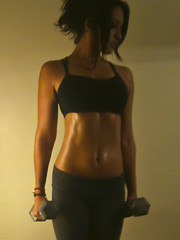- Click Here For More Specific Information On:
- Buy Sarms
Submitted by: Charles Inniss
In fitness the biggest fascination in fitness is getting a flat stomach or having washboard abs, but in this article I want to talk about the anatomy of the ab muscles.
There are 4 muscles in the anterior (front) abdominal wall. They are the rectus abdominus, the external oblique, the internal oblique and the transversus abdominus.
The rectus abdominus might be the most popular ab muscle because this is the muscle that makes up the 6 pack. The rectus abdominus runs straight down the abdomen and attaches the ribs to the pelvis. It works really hard when you do crunches and sit ups or any other exercise in which your spine bends forward against resistance.
The rectus abdominus is primarily a mover of the spine, but in addition it helps to stabilize the pelvis and lower back.
The external oblique is located on both sides of your waist. This muscle goes diagonally from the back of your lower ribs down to your pelvis. The external obliques on both sides work to help your spine bend forward like in crunches and sit ups, so when you so crunches all of your ab muscles work.
However, if you want to emphasize the obliques you need to incorporate twisting, rotation, or side-bending. When you turn your legs to the side or twist your body at the top part of a sit up or crunch your external oblique muscle will work harder than during a regular crunch.
The internal oblique is located underneath the external oblique. It goes diagonally from the pelvis up to the lower ribs. Just like the external oblique, the internal oblique works during regular crunches, but it is emphasized with twisting or rotation.
The internal obliques are built more for stability since they are deeper and closer to the spine. Isometric side planks are a good exercise for the internal obliques.
The fourth abdominal muscle is the transversus abdominus. Although it is the least popular muscle, many physical therapists think it is the most important muscle.
As the name suggests, the transverse abdominus runs across the abdomen. It is the deepest of all the abdominal muscles, and since it is so close to the spine it is the major abdominal stabilizer of the spine. The transversus abdominus does not move the spine forwards or help it to twist and rotate. The only function of the transversus abdominus is to stabilize the spine and stop it from moving.
Sometimes the transverse abdominus is referred to as your natural girdle because it acts like a girdle to keep your stomach pulled in. It will work during every movement and every ab exercise, but you can emphasize it by pulling your belly button towards your spine.
All of the abdominal muscles have a unique role, and all of them are important. In a fitness program, I suggest that you take an integrated approach and focus on different types of exercises to condition all of the abdominal muscles.
About the Author: Charles Inniss is a physical therapist and personal trainer. Visit his website to learn
the best stomach exercises
and learn
the best tummy flattening exercises.
Source:
isnare.com
Permanent Link:
isnare.com/?aid=440156&ca=Wellness%2C+Fitness+and+Diet




